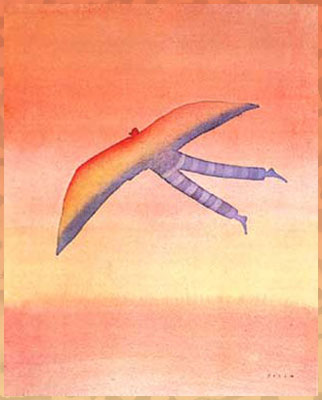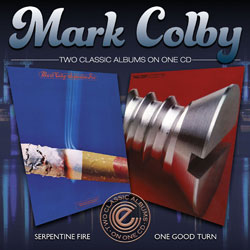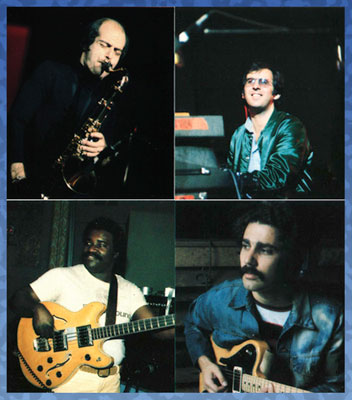Steve Khan's lead sheet:
"Rainbow Wings"(Khan)
As I had written awhile ago, the late '70s was a time when there seemed to be so much going on for me. Certainly the biggest event was getting signed to Columbia Records by Bob James, and being afforded the great privilege of recording "TIGHTROPE," my first album as a leader in 1977. It was during that same year, I was asked to play on what was to become Maynard Ferguson's album, "NEW VINTAGE." Some lasting friendships with some wonderful musicians were forged during that project. Names like Peter Erskine; Gordon Johnson, Bobby Militello; Biff Hannon; Joe Mosello; Tony Romano(sound engineer); and Mark Colby can be found on that recording.
Not too long afterwards, Bob James launched his own Tappan Zee Records label, and one of his first artist signings was saxophonist, Mark Colby. Soon thereafter, I was asked to play on Mark's first album, "SERPENTINE FIRE," which was produced by Jay Chattaway, with Bob contributing mightily to the various arrangements and choices of material. As this was in 1978, I was very excited, because Bob had asked me to submit a tune for the album, and I brought in the piece, "Rainbow Wings" which appeared on that LP. One year later, 1979, when Mark's 2nd album, "ONE GOOD TURN," was recorded, again, I was asked to bring in a tune, and that song turned out to be "Macbeth," which has already been featured here at KORNER 2. Like so many of my tunes from that period of time and beyond, the burden of coming up with titles was made easier, because I could just look around my then apartment and see various framed Jean-Michel Folon posters, and from there, I would just attach a title of my own creation, in English, to the tunes. There is no Folon painting with the title Rainbow Wings, the image is a watercolor that became a very famous poster for Amnesty International, which was commissioned in 1977. Here we are, it is now the tail-end of 2015, and both Mark Colby albums from this period have been released for the 1st time on CD as a 2-fer by Expansion Records(UK).
When we gathered together to record this tune at Mediasound Studios in New York, present, in addition to Mark and myself, were Bob James(Rhodes & Oberheim Polyphonic Synth); Gary King(El. Bass); Steve Gadd(Drums); and Rubens Bassini(Perc.). Until the release of this reissue package, I never possessed a digital copy of this tune and, even though I do have the LP version, I rarely listen to any of the recordings that I have in that format. However, I did dig into the deep recesses of my music files and found the original lead sheets for "Rainbow Wings." When I was finally able to actually listen to the tune and the performance again, and follow along with my lead sheet, I again realized how many wonderful contributions each musicians made to make the music on those pieces of paper come to life - and, in a far better version than I could have imagined at that time. Especially impressive for me was the playing and spontaneous arranging contributions from Bob James, and the tremendous drumming of Steve Gadd.
One of the great things about working alongside a keyboard artist like Bob James is that his sense of accompaniment is always in beautiful taste, but, more than that, he plays as if he is already hearing an arrangement going by in his imagination. You can hear his mind working as you're playing, right in the moment. Beyond that, he has the experience, the courage and the self-confidence to make musical decisions that, in the end, serve to better the composition as it was presented on the lead sheet. There are touches that he brought to "Rainbow Wings" that I certainly had not thought of, and the newly revised lead sheet that you now see here represents these additions that Bob made. The first thing that you now hear at letter [I] was completely of Bob's creation. Originally, there was no Intro and, with a tenor sax pick-up, we just went right into the tune at letter [A]. Bob decided to play the first 3 chords on his Rhodes freely, but with a hint of tempo. When the chords are repeated, the resolution to an Emaj9 chord is all of Bob's invention. The best part of all of this for me, especially now being able to listen and look back, is that this brief exposition completely captures the mood and attitude that I was trying to convey with the whole piece. It is these very elements that are so important to me in anything and everything that I do and have done. Originally, there was no Intro and, with a tenor sax pick-up, we just went right into the tune at letter [A]. Bob decided to play the first 3 chords on his Rhodes freely, but with a hint of tempo. When the chords are repeated, the resolution to an Emaj9 chord is all of Bob's invention. The best part of all of this for me, especially now being able to listen and look back, is that this brief exposition completely captures the mood and attitude that I was trying to convey with the whole piece. It is these very elements that are so important to me in anything and everything that I do and have done.
The lead sheet is presented in mini-score form to accommodate the melody line, the keyboard accompaniment, and the bass part. The original version from 1978 was done this way as well. The melody line was probably written in the register for the guitar, an octave above where it actually sounds. My guess is that Mark Colby found that the piece was most expressive for his tenor sax if played where it was written and, of course, it sounds an octave lower, which puts it in a very warm and breathy register. One of the great things about handing out the music in mini-score form, especially when there is a drummer like Steve Gadd, who had the kind of consummate musicianship to be able to see all the parts and, as he is reading through the music, and listening, he is adding parts of his kit to what he sees. For example, during letter [A], notice how he catches the written accents in the bass part with his kick drum. It is all played with precision but great subtlety as well. During the [B] section, Steve changes the groove to more an R&B or funk-based attitude while also using his incredible control and creativity on the snare drum. Looking back, I loved hearing how Steve decided to add in the phrasing of Mark's melody in bar 4 with the quarter-note triplets. Looking at my original lead sheets, I did not write it out this way, the rhythms were different. But Steve just heard Mark's change in the phrasing and went with it. Again, they took something that was there and changed it for the better - all for musical reasons. When one is the composer, these are the kinds of small details that you learn to let go of, because your bandmates can have better ideas!
After a brief reprise of letter [A], and this time taking the 2nd Ending, and then, observing the Coda which takes us to the solo section, [C]. It was nice to see that Mark was afforded plenty of time and space for his solo to unfold and this element alone give the piece a very 'live' feeling to it. After all, this is the way that most of us are used to playing - it's just a matter of transporting that feeling from the stage to the studio. Once again, as constructed the solo section, initially played with the same 1/2-time R&B/Funk feel primarily enunciated by Steve Gadd's drumming, plays through as it was written. After observing both the 1st and 2nd Endings, the rhythmic feeling expands to double-time and allows Mark to explore these simple harmonic areas more freely. Notice how my guitar accompaniment now takes on the role of playing long tones with support from Bob James, but it is Bob who supplies more the chordal punctuations as he responds to both Mark's soloing and Steve Gadd's sense of interplay. If you have the complete version of the tune, at about the 4-minute mark, you hear that Bob added a wonderful Oberheim orchestration to add to the building tension. It was all beautifully done!!! After observing both the 1st and 2nd Endings, the rhythmic feeling expands to double-time and allows Mark to explore these simple harmonic areas more freely. Notice how my guitar accompaniment now takes on the role of playing long tones with support from Bob James, but it is Bob who supplies more the chordal punctuations as he responds to both Mark's soloing and Steve Gadd's sense of interplay. If you have the complete version of the tune, at about the 4-minute mark, you hear that Bob added a wonderful Oberheim orchestration to add to the building tension. It was all beautifully done!!!
As Mark's tremendous solo arrives at its conclusion, the piece now observes a D.C., and returns to the top for a reprise of the Bob's solo synth Intro, letter [I], but this time, it is played completely in time, and not rubato, or freely, as it was performed when the tune began. To close the piece out, and I have no recollection just how this was decided, but I would imagine that it was another great suggestion by Bob James, we actually play [A] with the 1st Ending two times, and then, as we state the theme for the 3rd time, Bob adds another nice Oberheim orchestration as we take the 2nd Ending and arrive at the fermata over the final chord. Again, this touch was not on my original lead sheet and is a reflection of the good things that can happen when musicians communicate with one another and offer suggestions born of years of experience and immense musicality. I can only offer my huge "Thanks!" to Bob for all that he contributed to making "Rainbow Wings" much better than what I had originally written.
Though, in its way, the original lead sheet/mini-score was still relatively neat and tidy, it did seem rather primitive and unprofessional looking. My guilt over this state of affairs inspired me to completely rewrite the lead sheet, and that is what you can now view here. Though I sometimes receive complaints from musicians and fans who would prefer to see the lead sheets and transcriptions presented as pdfs done with Finale or Sibelius, I must always tell them that I actually enjoy doing them by hand, and that if one follows the printing GUIDE I offer, it is possible to get a very nice looking print-out.
If I may, I would like to take a moment to remember our Brasilian percussionist, Rubens Bassini who brought his beautiful musical and spiritual personality to this recording and many, many others and was really one of the first musicians in our community that I remember losing, and way too soon. He passed away in 1985 at the age of 52, but truth be told, his way of bringing a smile to everything made him seem like a perpetual person of youth!!! We have missed him here in New York ever since. For me, it's a great honor that he was a part of "Rainbow Wings." I can't leave this segment without, once again, acknowledging the loss bassist Gary King, who passed away way too soon in 2003. Another huge presence who brought so much energy and creativity to any project. For me, it is wonderful to remember that Gary was a part of this tune too.
As I restate what I have expressed many times here at the site, I remain ever-grateful to Bob James for having given me the opportunity to bring in a tune for Mark Colby's 1st and 2nd albums. I remain very moved that Bob had this kind of confidence in my musical abilities at that time. Honestly, most times, I don't feel that I was ready for that, nor was my musicianship on the same level as the other players. It's very humbling to reflect, and perceive a certain truth. As I am writing this in November of 2015, I have certainly had enough time, years upon which to reflect back to those days. I am just going to hope that those of you who consistently visit these pages will find something rewarding and interesting while exploring this particular tune.
As we say "Goodbye!" to 2015, we want to wish everyone a very
MERRY
CHRISTMAS and a ¡FELIZ
NAVIDAD! And, of course, soon it will be time to say, yet again, HAPPY NEW YEAR!!! Y por supuesto, les deseamos un muy ¡FELIZ
AÑO NUEVO!
Wishing you all good health, happiness, and please, maybe in 2016 we can achieve some small measure of PEACE everywhere!!! One grows weary of the constant chaos and bad feelings that exist in every part of our planet.
[Jean-Michel Folon's watercolor, "International Amensty Poster"
Collage: Top: Mark Colby-Bob James Bottom: Gary King-Steve Khan Photos: David Gahr, taken in 1978]
|

